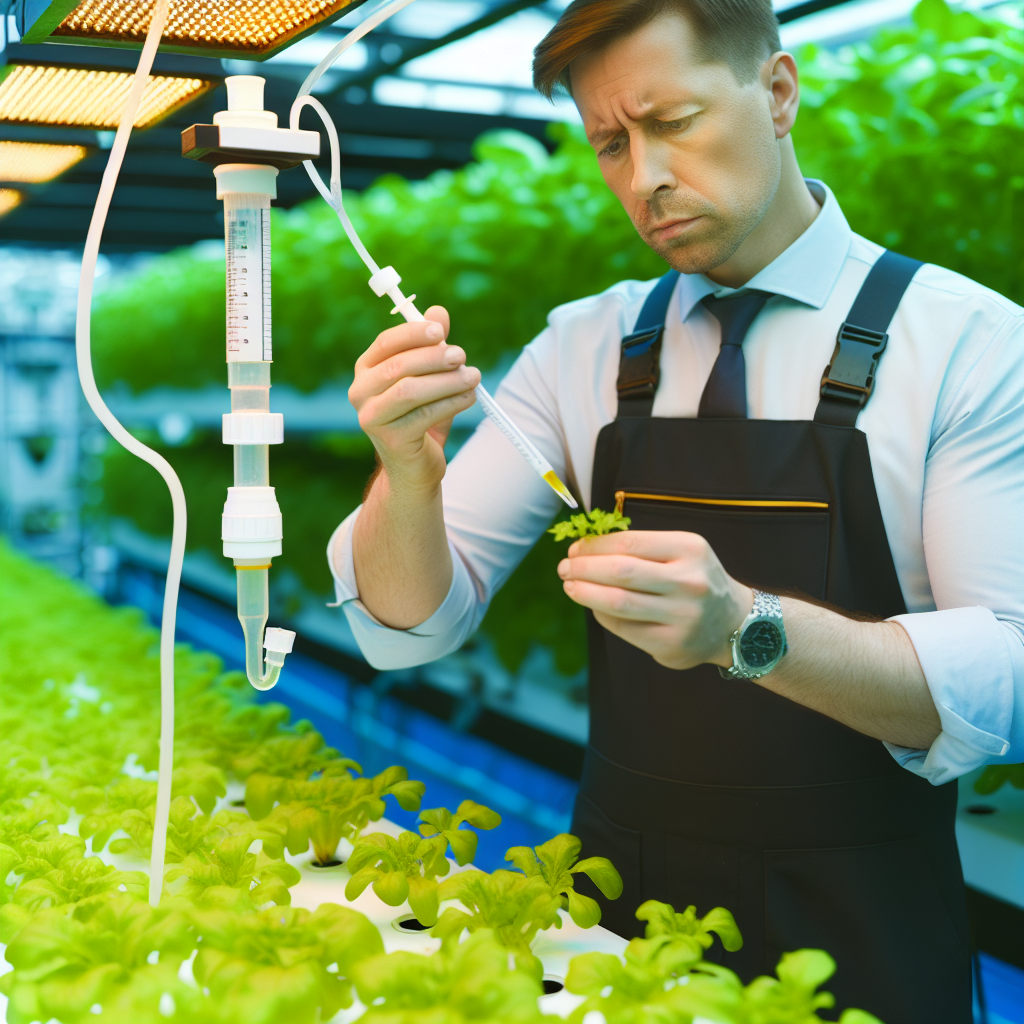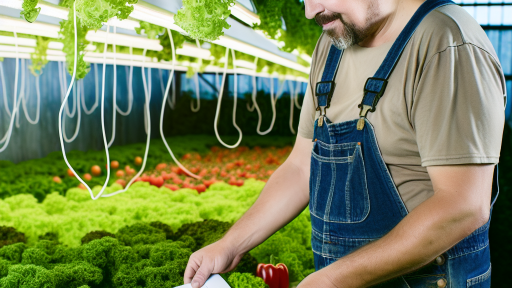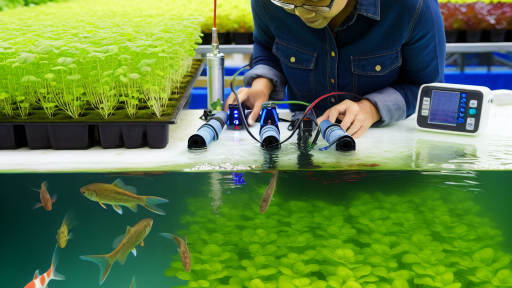Introduction to Hydroponics
Hydroponics is a revolutionary method of growing plants without soil.
Instead, this technique utilizes nutrient-rich water solutions.
This contributes to faster plant growth and higher yields.
Farmers and hobbyists alike can benefit from hydroponic systems.
Furthermore, hydroponics significantly reduces water usage.
It minimizes the need for pesticides, resulting in healthier produce.
In urban environments, hydroponics is indispensable for local food production.
It allows growers to cultivate fresh crops in limited spaces.
Moreover, this method promotes sustainable agricultural practices.
Understanding hydroponics is crucial for modern farming techniques.
As global demand for food rises, so does the importance of hydroponics.
Benefits of Hydroponics
Hydroponics offers numerous advantages over traditional farming methods.
Firstly, it enables year-round crop production.
With controlled environments, plants thrive regardless of weather conditions.
This leads to consistent harvests and stable income for growers.
Transform Your Agribusiness
Unlock your farm's potential with expert advice tailored to your needs. Get actionable steps that drive real results.
Get StartedSecondly, hydroponics maximizes space efficiency.
Vertical farming techniques allow for densified crop areas.
In addition, nutrient absorption is optimized, enhancing growth rates.
Finally, reduced transportation costs further increase profitability.
This is particularly beneficial in urban and densely populated areas.
Key Components of Hydroponic Systems
Successful hydroponic systems rely on several essential components.
These include a growing medium, a water delivery system, and nutrients.
Common growing media include Rockwool, perlite, and coconut coir.
Each provides support while allowing adequate drainage and aeration.
The water delivery system circulates the nutrient solution effectively.
Additionally, light sources, such as LED grow lights, support photosynthesis.
Moreover, pH and nutrient levels must be monitored constantly.
This ensures optimal growth conditions for various plant species.
Understanding these components guarantees greater success in hydroponics.
The Role of Nutrients in Plant Growth
Nutrients play a vital role in the development of plants.
They support essential processes, like photosynthesis and respiration.
Without adequate nutrients, plants cannot thrive or produce effectively.
Essential Nutrients for Hydroponic Systems
Hydroponics relies heavily on nutrient solutions to support plant life.
These solutions need to include both macronutrients and micronutrients.
Macronutrients include nitrogen, phosphorus, and potassium, among others.
Micronutrients like iron, manganese, and zinc are also crucial for growth.
Nutrient Uptake Mechanism
Plants absorb nutrients through their roots in hydroponic systems.
This process relies on the availability of nutrient ions in the water.
Moreover, the pH level of the water influences nutrient availability.
Showcase Your Farming Business
Publish your professional farming services profile on our blog for a one-time fee of $200 and reach a dedicated audience of farmers and agribusiness owners.
Publish Your ProfileMaintaining optimal pH ensures efficient nutrient uptake by plants.
Visual Indicators of Nutrient Deficiency
Healthy plants display vibrant leaves and strong stems.
Yellowing leaves may indicate a nitrogen deficiency.
On the other hand, drooping leaves can signal a potassium shortage.
Therefore, growers must monitor plants closely for these signs.
Balancing Nutrient Solutions
Creating a balanced nutrient solution is essential for plant vitality.
Regularly testing and adjusting the nutrient levels ensures optimal growth.
Utilizing hydroponic nutrient formulas simplifies this process.
However, growers must tailor these solutions to specific plant needs.
Macronutrients for Hydroponic Growth
Nitrogen
Nitrogen is vital for plant growth and development.
It plays a key role in synthesizing amino acids and proteins.
Moreover, nitrogen influences chlorophyll production.
Healthy chlorophyll levels enhance photosynthesis efficiency.
In hydroponics, plants require readily available nitrogen forms.
Common nitrogen sources include nitrates and ammonium.
Too much nitrogen can lead to excessive leaf growth.
This imbalance may hinder fruit and flower development.
Phosphorus
Phosphorus is essential for energy transfer within plants.
It helps form ATP, which powers many plant processes.
This macronutrient is crucial for root development.
A robust root system improves overall nutrient uptake.
In hydroponics, phosphorus is often provided as phosphate.
Plants with adequate phosphorus exhibit strong flowering.
However, excessive phosphorus can lead to nutritional imbalances.
This may cause competition among other essential elements.
Potassium
Potassium contributes to water regulation and nutrient transport.
It enhances plant resilience against diseases and environmental stress.
Potassium’s role in photosynthesis cannot be overlooked.
It aids in the synthesis of various proteins and enzymes.
In hydroponic systems, potassium should be readily available.
Ensure a balance to prevent deficiencies and toxicities.
Proper potassium levels improve fruit quality and yield.
Regular monitoring is essential for optimal hydroponic performance.
Explore Further: Protecting Heirloom Varieties from Pests
Micronutrients: Essential Elements for Optimal Growth
Introduction to Micronutrients
Plants require micronutrients in small amounts for healthy growth.
These essential elements support various physiological functions.
Without them, plants may suffer from deficiencies and stunted growth.
Key Micronutrients
Several micronutrients are vital for hydroponic systems.
They include iron, manganese, zinc, copper, molybdenum, and boron.
Each micronutrient plays a unique role in plant health.
Showcase Your Farming Business
Publish your professional farming services profile on our blog for a one-time fee of $200 and reach a dedicated audience of farmers and agribusiness owners.
Publish Your ProfileIron
Iron is crucial for chlorophyll production and energy transfer.
Deficiencies lead to yellowing leaves and reduced growth.
Manganese
Manganese assists in photosynthesis and nitrogen assimilation.
Insufficient manganese results in leaf chlorosis and spotting.
Zinc
Zinc is essential for enzyme function and growth regulation.
Without adequate zinc, plants may exhibit stunted growth and leaf distortion.
Copper
Copper supports photosynthesis, respiration, and lignin synthesis.
A lack of copper can cause wilting and poor root development.
Molybdenum
Molybdenum aids in nitrogen utilization and enzyme activity.
Deficiency can lead to nitrate accumulation and yellowing leaves.
Boron
Boron plays a significant role in cell wall formation and pollination.
Insufficient boron may result in flower drop and poor fruit development.
Balancing Micronutrient Levels
Maintaining proper levels of micronutrients is essential for optimal growth.
Regular testing of nutrient solutions can ensure balanced availability.
Adjustments may be necessary based on plant species and growth stages.
Micronutrients and Healthy Plant Development
Micronutrients are vital for healthy plant development in hydroponics.
Understanding their roles can enhance growth and yields.
By ensuring balanced micronutrient levels, growers can achieve excellent results.
Learn More: Enhancing Biodiversity with Heirloom Varieties
Water Quality and Its Impact on Nutrient Uptake
The Importance of Water Quality
Water quality plays a crucial role in hydroponic systems.
It directly impacts plant health and nutrient absorption.
Good quality water ensures optimal growth conditions.
Key Water Characteristics
Several key characteristics define water quality in hydroponics.
- pH level affects nutrient availability.
- Electrical conductivity (EC) measures nutrient concentration.
- Dissolved oxygen levels support root health.
Understanding pH Levels
The pH level must remain stable for effective nutrient uptake.
Most plants thrive in a pH range of 5.5 to 6.5.
Regular testing ensures that pH is within this optimal range.
Adjustments can be made using pH up or down solutions.
Electrical Conductivity Explained
Electrical conductivity indicates the solution’s nutrient concentration.
A higher EC value often indicates a more nutrient-rich solution.
However, excessive nutrients can harm plants.
Maintaining a balanced EC is essential for healthy growth.
Dissolved Oxygen and Root Health
Dissolved oxygen is crucial for aerobic respiration in roots.
Low oxygen levels can lead to root diseases.
To increase oxygen levels, consider using air stones or pumps.
Impact of Water Source
The source of water affects its quality and stability.
Tap water may contain chlorine or heavy metals.
Using filtered or distilled water can minimize these risks.
Regular Monitoring and Maintenance
Regular monitoring of water quality is imperative.
Schedule frequent checks to maintain optimal conditions.
This proactive approach will ensure healthy plant growth.
Showcase Your Farming Business
Publish your professional farming services profile on our blog for a one-time fee of $200 and reach a dedicated audience of farmers and agribusiness owners.
Publish Your ProfileWater Quality Fundamentals for Hydroponics
Water quality is fundamental to hydroponic success.
By controlling pH, EC, and oxygen levels, you can enhance nutrient uptake.
Investing time in monitoring will pay off with thriving plants.
Discover More: Maximizing Yields in Hydroponic Systems

Nutrient Solutions: Types and Preparation Methods
Understanding Nutrient Solutions
Nutrient solutions provide essential elements for plants in hydroponic systems.
These solutions allow plants to absorb nutrients directly through their roots.
Hydroponic nutrient solutions typically contain macronutrients and micronutrients.
Macronutrients include nitrogen, phosphorus, potassium, calcium, magnesium, and sulfur.
Meanwhile, micronutrients consist of iron, manganese, zinc, copper, molybdenum, and boron.
Types of Nutrient Solutions
There are two main types of nutrient solutions: premixed and custom-made.
Premixed solutions are commercially available for convenience.
Custom-made solutions allow growers to tailor nutrient content to specific plants.
Additionally, different plants may require different nutrient concentrations.
Premixed Solutions
Premixed solutions are often balanced and easy to use.
They typically come with clear instructions for dilution and application.
Using premixed solutions can save time and reduce errors.
Popular brands include General Hydroponics and Advanced Nutrients.
Custom-Made Solutions
Custom-made solutions give growers more control over nutrient levels.
This flexibility helps to optimize growth for various plant species.
Using this method requires some knowledge of plant nutrition.
Each component must be measured and mixed carefully.
Preparation Methods
Preparing nutrient solutions involves mixing water with nutrient salts.
It’s essential to use clean, pH-balanced water to ensure effectiveness.
Growers can use distilled or reverse osmosis water for optimal results.
Mixing Process
Start by measuring the desired amount of water into a clean container.
Next, add the nutrient salts according to the manufacturer’s instructions.
Use a scale for precision to achieve the correct nutrient concentration.
Stir the solution thoroughly to ensure all salts dissolve completely.
pH Adjustment
After mixing, test the pH level of the nutrient solution.
The ideal pH range for most hydroponic plants is between 5.5 and 6.5.
Adjust the pH using pH up or pH down solutions as necessary.
Regular monitoring of pH levels helps maintain nutrient uptake efficiency.
You Might Also Like: Pest Management in Hydroponic Farming
Monitoring and Adjusting Nutrient Levels in Hydroponics
Importance of Nutrient Monitoring
Nutrient monitoring plays a vital role in hydroponics.
It ensures plants receive essential nutrients for growth.
Moreover, it prevents nutrient deficiencies or toxicities.
Tools for Monitoring Nutrient Levels
Using reliable tools enhances nutrient management.
Consider digital pH meters for accurate readings.
Electrical conductivity (EC) meters help measure nutrient concentration.
Calibration solutions maintain the precision of these tools.
Showcase Your Farming Business
Publish your professional farming services profile on our blog for a one-time fee of $200 and reach a dedicated audience of farmers and agribusiness owners.
Publish Your ProfileFrequency of Nutrient Monitoring
Regular monitoring keeps your system in check.
Check nutrient levels at least once a week.
Increase frequency during rapid plant growth stages.
Adjusting Nutrient Levels
Adjusting nutrient levels requires careful consideration.
Increase nutrient solutions based on plant growth phase.
For example, young plants need different nutrient concentrations compared to mature ones.
Common Nutrient Adjustments
Be aware of common nutrient adjustments.
- Increase nitrogen during vegetative growth.
- Boost phosphorus and potassium during flowering.
- Monitor calcium and magnesium for overall plant health.
Signs of Nutrient Deficiency
Recognizing deficiency symptoms aids in timely adjustments.
Yellowing leaves often indicate nitrogen deficiency.
Brown leaf edges may suggest potassium deficiency.
Evaluating Nutrient Solutions
Regularly evaluate your nutrient solutions.
Consider changing solutions every two weeks.
This practice prevents nutrient buildup and promotes balanced growth.
Water Quality and Its Impact
Water quality significantly impacts nutrient availability.
Test for chlorine and heavy metals in water sources.
Filter or treat water to enhance nutrient absorption.
Common Nutrient Deficiencies: Identification and Solutions
Identifying Nutrient Deficiencies
Nutrient deficiencies can significantly impact hydroponic growth.
It’s essential to recognize the symptoms early.
Each nutrient deficiency presents unique symptoms.
Clients often report stunted growth and yellowing leaves.
Each plant species may exhibit different signs.
Monitoring your plants regularly helps in early detection.
Common Nutrient Deficiencies
Several nutrients are crucial for optimal plant health.
Here are common deficiencies you might encounter:
- Nitrogen deficiency often causes yellowing of older leaves.
- Phosphorus deficiency leads to dark green or purplish leaves.
- Potassium deficiency results in brown leaf edges.
- Calcium deficiency manifests as blossom end rot in fruits.
- Magnesium deficiency typically causes interveinal chlorosis.
Solutions for Nutrient Deficiencies
Providing the right nutrients resolves deficiencies effectively.
First, perform a nutrient analysis of your hydroponic solution.
This step helps identify which nutrients are lacking.
Next, consider adding specific nutrient solutions.
You can purchase commercial fertilizers tailored for hydroponics.
Additionally, frequent monitoring ensures timely adjustments.
Moreover, proper pH levels promote nutrient availability.
Preventative Measures
Preventing nutrient deficiencies is easier than correcting them.
Maintain balanced nutrient concentrations in your systems.
Additionally, consider including an annual nutrient replenishment schedule.
Routine checks of the system will prevent future issues.
Furthermore, ensure plants receive adequate light and airflow.
This support helps enhance nutrient absorption capabilities.
Additional Resources
Small-scale hydroponics | UMN Extension
Automated agriculture: Building a DIY hydroponic gardening system …




